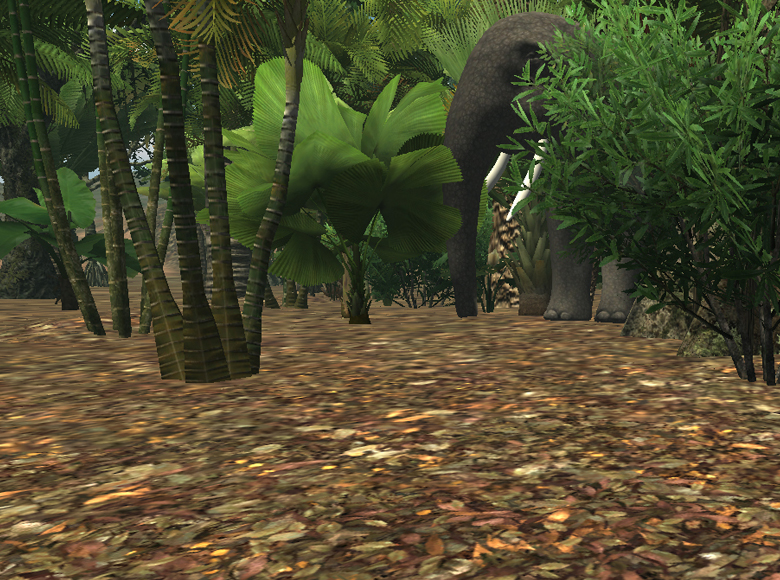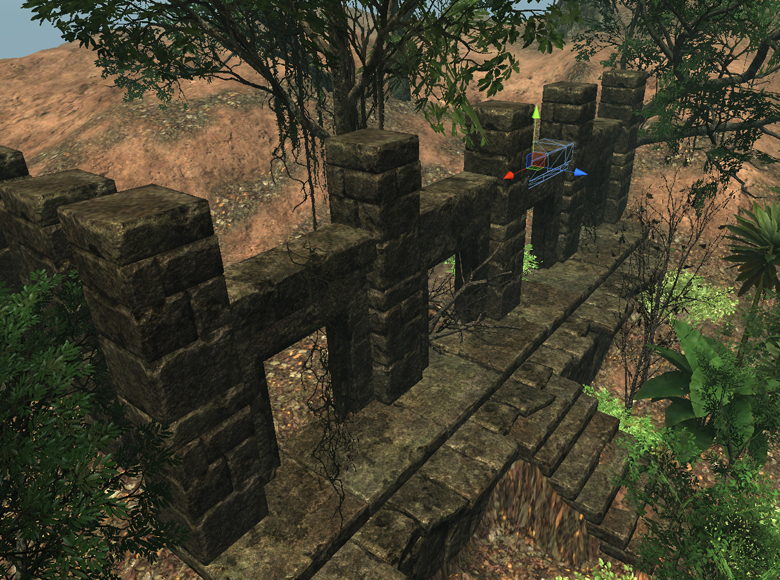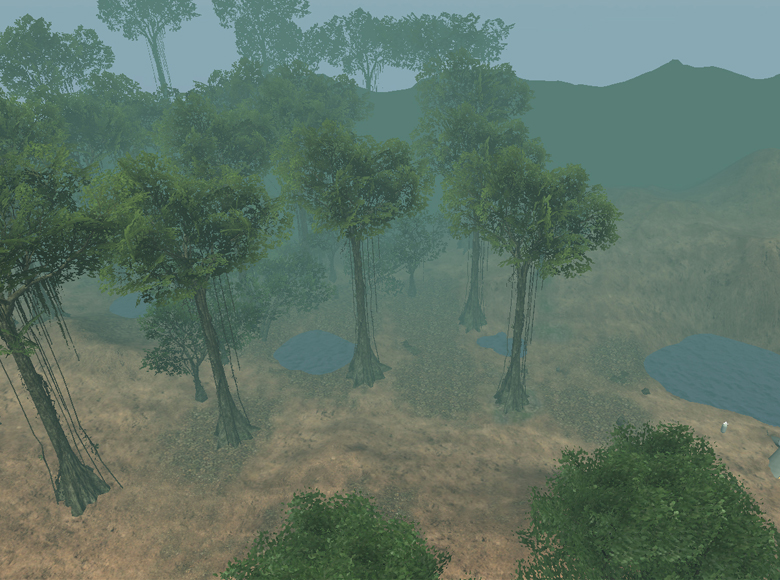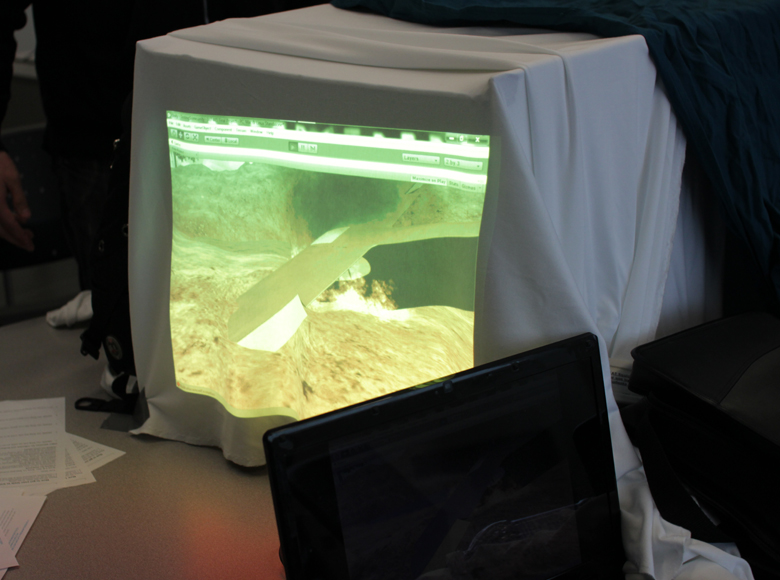Portfolio
Final Project - Crashed
April 12th, 2013
For the Final Project, Crashed, our team decided to continue with the jungle theme from Assignment #3 but on a larger scale and with increased immersion factors to create a more compelling experience. I worked with a team of 3 people (Kelvin Leung, Neil Pense, and myself) to create a jungle environment where the player is standed after being the lone survivor in a plane crash. The player must then navigate their way through a dense jungle area to locate a medical kit to treat their injuried. Along the way there are scattered debris (such as painkiller pills) which work to guide the player in the right direction.
Large JPG Files
Image #1 - Game Environment
Image #2 - Ruins Area
Image #3 - Lake Overview
Image #4 - Lake and Deer
Image #5 - Jungle from Above
Image #6 - Physical Setup
Skills
With this specific project, the main skills I utilized included 3D modeling and asset creation, texture work, designing believable soundscapes, and creating entire environments within Unity 3D using a combination of the above skills. I possess knowledge of many industry-standard programs, including Autodesk Maya & 3ds Max, Sculptris, the Adobe Suite, and various game-engines (specifically CryEngine 3 and GameMaker). More information regarding my other skills can be found on the About page of this portfolio!
Design Process
At the start of this project, we were a bit indecisive about a final theme. However, we eventually began thinking about what environments that we personally were familiar enough with to create a realistic experience, and Kelvin had recently been to Panama last Summer, which seemed like a nice opportunity for us to create a non-typical environment which would also be compelling to the player. We took an iterative approach to design, spending a lot of time researching jungle-environments online and then cross-referencing it with Kelvin in order to determine what parts would be most compelling to the average player. Amongst the things we researched were wildlife, visuals, and the auditory experience of a typical jungle. We then translated this into Unity over several stages (adding terrain, props, foliage etc.). After gaining feedback from real players, we went back again to make some more changes to the environment and create a more effective narrative which would encourage exploration in the way we intended. For this, we implemented a medic kit that the player must find to help resolve their injuries. Along the way we placed other debris which would help to guide the player along the right path. Alongside the design of our digital environment, we also thought about how to create our physical setup to complement this. We decided that a setup which occludes the surrounding world would work best for immersion. We originally struggled with getting a projector to work, so for the final revision we projected backwards onto a thin cloth and flipped the controls so that they were no longer inverted to the player (since the image was inverted as a result of the projection method). We feel that this worked well in accomplishing the experience we desired.
Theoretical Guidance
The Immersion Framework (by Jay Vidyarthi) allowed us to apply proper terminology and classify the components of our project as needed. We found that the principals within the framework gave us new perspectives and techniques with which we could use to create immersion. The framework was challenging at first to get a grasp of understanding, but after seeing Jay's guest lecture it was much clearer. Understanding it allowed us to design our environment with the Immersion Framework in mind and help accomplish our intended user experience. Specifically, it let us consider which elements of our project would have the most effect on the players, and then hone our focus in on those aspects a bit more to refine it as much as possible. In Jay's lecture regarding his Immersion Framework, he discusses the Constructive Model of Immersion, which was a basis for how we constructed our digital world. We took consideration of this aspect in making assets within our game which would draw on previous knowledge of jungle settings which the players had likely seen through common media. This allowed us to create a plausible setting which would create the types of immersion we intended.
Individual Contribution
My personal role in this project consisted of:
-
Helping with the creation of the main Unity scene and placing props to create a jungle which seemed dense (without adding too much which would cause excessive lag on our machine).
- Create animal props, a plane, and other miscallaneous assets
using Maya and Sculptris.
- Researching and implementation of an Instant Occlusion Culling solution for Unity to prevent lag from ruining user experience due to the density of the jungle.
- Collecting and recording sound effects to create an immersive soundscape for the jungle.
- Researching how to use needed scripts for certain functions in-game.
- Helping write and designing the layout of the Executive Summary.
- Working with the team to determine what options would be best for our physical setup.
List of Learning Outcomes:
- Enhanced my skills in working with Unity 3D by assessing and correcting problems I discovered in the creation of our scene.
- Improved my ability to create an immersive soundscape by testing out different sounds, volumes, and types of roll-off to get the correct atmosphere.
- Got to practice creating and modifying textures to be seamless.
- Learned to adapt the scene based off of user feedback and improve the overall narrative.
- Got to improve my modeling and texture mapping skills while under a poly-count constraint.
- Extra practice in making scripts work correctly.
Program(s) Used:
- Unity 3D
- Adobe Photoshop
- Autodesk Maya
- Autodesk 3ds Max
- Sculptris
- Adobe Audition
Extra Links
Project Video
Executive Summary (Right Click + Save Link As to download)






